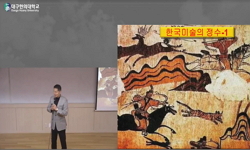이 글은 칸트의 �판단력비판�에서 “미감적 판단력”을 중심으로, 합목적성과 미적 쾌 및 숭고 감정 간의 관계를 고찰한다. 칸트는 미감적 판단력의 선험적 원리를 합목적성으로 규정하...
http://chineseinput.net/에서 pinyin(병음)방식으로 중국어를 변환할 수 있습니다.
변환된 중국어를 복사하여 사용하시면 됩니다.
- 中文 을 입력하시려면 zhongwen을 입력하시고 space를누르시면됩니다.
- 北京 을 입력하시려면 beijing을 입력하시고 space를 누르시면 됩니다.

칸트 『판단력비판』에서 합목적성과 미감적 감정의 관계 = The relationship between purposefulness and aesthetic feeling in Kant’ s Criti que of Jud gment
한글로보기https://www.riss.kr/link?id=A109784930
-
저자
하진숙 (부산대학교 한국민족문화연구소)
- 발행기관
- 학술지명
- 권호사항
-
발행연도
2025
-
작성언어
Korean
-
주제어
미감적 판단력 ; 합목적성 ; 미 ; 숭고 ; 도덕 감정 ; aesthetic power of judgment ; purposiveness ; the beauty ; the sublime ; moral feeling
-
등재정보
KCI등재
-
자료형태
학술저널
- 발행기관 URL
-
수록면
278-305(28쪽)
- 제공처
-
0
상세조회 -
0
다운로드
부가정보
국문 초록 (Abstract)
이 글은 칸트의 �판단력비판�에서 “미감적 판단력”을 중심으로, 합목적성과 미적 쾌 및 숭고 감정 간의 관계를 고찰한다. 칸트는 미감적 판단력의 선험적 원리를 합목적성으로 규정하면서, 합목적성이 취미판단과 숭고판단에서 각각 다르게 성립된다고 설명한다. 취미판단에서는 합목적성이 대상의 표상과 주관의 인식력들과의 조화에서 성립된다. 이를 위해서는 대상이 인식력들의 상호작용을 가능하게 하는 한정된 형식으로 제시되어야 한다. 반면 숭고 판단에서는 직관이 포착할 수 없는몰형식적인 대상이나 무한정성이 표상되는 대상이 요구된다. 따라서 상상력이 대상의 형식과 관계하는 것이 아니라 무한을 떠올릴 수 있는 주관의 이성과 관계한다. 이처럼 합목적성이 성립되는 방식의 차이는 인식력들의 합목적적 관계를 의식할 때 느끼는 감정의 차이로 이어지며, 이는 곧 미적쾌와 숭고 감정의 차이를 낳는다. 미적 쾌는 상상력과 오성이 자유롭게 유희할 때 의식되는 직접적인 생명의 고양감이지만 숭고 감정은 상상력이 대상을 파악하지 못하는 한계로부터 이성을 환기시킬 때 일어나는 존경과 경외의 감정이다. 이는 생명력이 일순간 저지되었다가 한층 더 강력하게 일어나는 부정적 쾌의 감정이다. 칸트는 이러한 감정의 차이에도 불구하고 양자를 통일할 수 있는 근거를 도덕적 감정과의 합목적적 관계에서 찾는다. 판단력을 합목적적으로 사용하는 이유는 감관적향수로부터 도덕적 감정에로 이행하고, 이성법칙에 대한 존경을 미감적인 방식으로 느끼는데 있다는 것이다. 이는 미감적 판단이 비록 형식적이라 하더라도 도덕적 감정과 합치할 때만이 주관 안에서 합목적성을 얻게 된다는 것을 의미한다. 칸트의 비판 작업은 반성적 판단력을 통해 인간의 인식능력을 통합하고, 합목적성의 원리 아래 자연을 더 고차적으로 이해하려는데 목적이 있다.
다국어 초록 (Multilingual Abstract)
” Kant defines the transcendental principle of aesthetic judgment as purposiveness, and explains that this principle operates differently in judgments of taste and judgments of the sublime. In judgments of taste, purposiveness arises from the harmony between the representation of the object and the cognitive faculties of the subject. To make this possible, the object must be presented in a limited form that allows the interaction of the cognitive faculties. In contrast, in the judgment of the sublime, the object must be presented as representing a formless infinity that cannot be grasped through intuition. In the judgment of the sublime, imagination is not related to the form of the object, but to reason, and thus evokes the idea of infinity. This difference in the way in which purposiveness operates leads to differences in the feelings experienced when perceiving aesthetic qualities. Aesthetic pleasure arises from the free play of imagination and intellect, and evokes a direct sense of vitality.
Conversely, the feeling of the sublime arises when imagination fails to grasp the totality of the object, and this stimulates reason, evoking feelings of respect and awe. This negative pleasure occurs when vitality is momentarily blocked and then reactivated with greater intensity. Despite these differences, Kant finds the unifying ground of aesthetic judgment in its purposive relationship with moral feeling. The reason for using aesthetic judgment purposively is to experience respect for the moral law in an aesthetic way through the transition from sensory satisfaction to moral feeling. This suggests that aesthetic judgment, even if formal, acquires purposiveness within the subject only when it is consistent with moral feeling. Ultimately, Kant’ s critique aims to integrate human cognitive ability through reflective judgment and to understand nature in a higher order under the principle of purposiveness.
This paper explores the relationship between purposiveness, aesthetic pleasure, and the feeling of the sublime in Kant’ s Critique of Judgment, focusing on the “ power of aesthetic judgment. ” Kant defines the transcendental principle of aesthet...
This paper explores the relationship between purposiveness, aesthetic pleasure, and the feeling of the sublime in Kant’ s Critique of Judgment, focusing on the “ power of aesthetic judgment.
” Kant defines the transcendental principle of aesthetic judgment as purposiveness, and explains that this principle operates differently in judgments of taste and judgments of the sublime. In judgments of taste, purposiveness arises from the harmony between the representation of the object and the cognitive faculties of the subject. To make this possible, the object must be presented in a limited form that allows the interaction of the cognitive faculties. In contrast, in the judgment of the sublime, the object must be presented as representing a formless infinity that cannot be grasped through intuition. In the judgment of the sublime, imagination is not related to the form of the object, but to reason, and thus evokes the idea of infinity. This difference in the way in which purposiveness operates leads to differences in the feelings experienced when perceiving aesthetic qualities. Aesthetic pleasure arises from the free play of imagination and intellect, and evokes a direct sense of vitality.
Conversely, the feeling of the sublime arises when imagination fails to grasp the totality of the object, and this stimulates reason, evoking feelings of respect and awe. This negative pleasure occurs when vitality is momentarily blocked and then reactivated with greater intensity. Despite these differences, Kant finds the unifying ground of aesthetic judgment in its purposive relationship with moral feeling. The reason for using aesthetic judgment purposively is to experience respect for the moral law in an aesthetic way through the transition from sensory satisfaction to moral feeling. This suggests that aesthetic judgment, even if formal, acquires purposiveness within the subject only when it is consistent with moral feeling. Ultimately, Kant’ s critique aims to integrate human cognitive ability through reflective judgment and to understand nature in a higher order under the principle of purposiveness.
동일학술지(권/호) 다른 논문
-
- 대동철학회
- 왕연자
- 2025
- KCI등재
-
하리발마의 해석에 근거한 초기불교 공삼매(空三昧)의 의미
- 대동철학회
- 김준호
- 2025
- KCI등재
-
- 대동철학회
- 남재민
- 2025
- KCI등재
-
- 대동철학회
- 박인정
- 2025
- KCI등재




 KCI
KCI eArticle
eArticle





